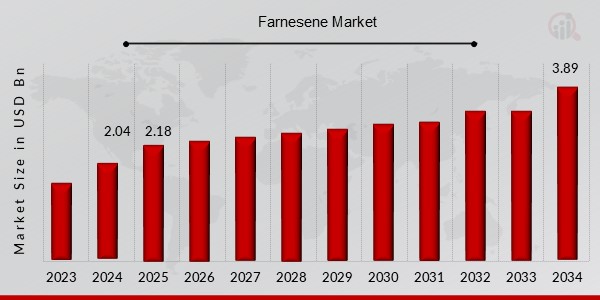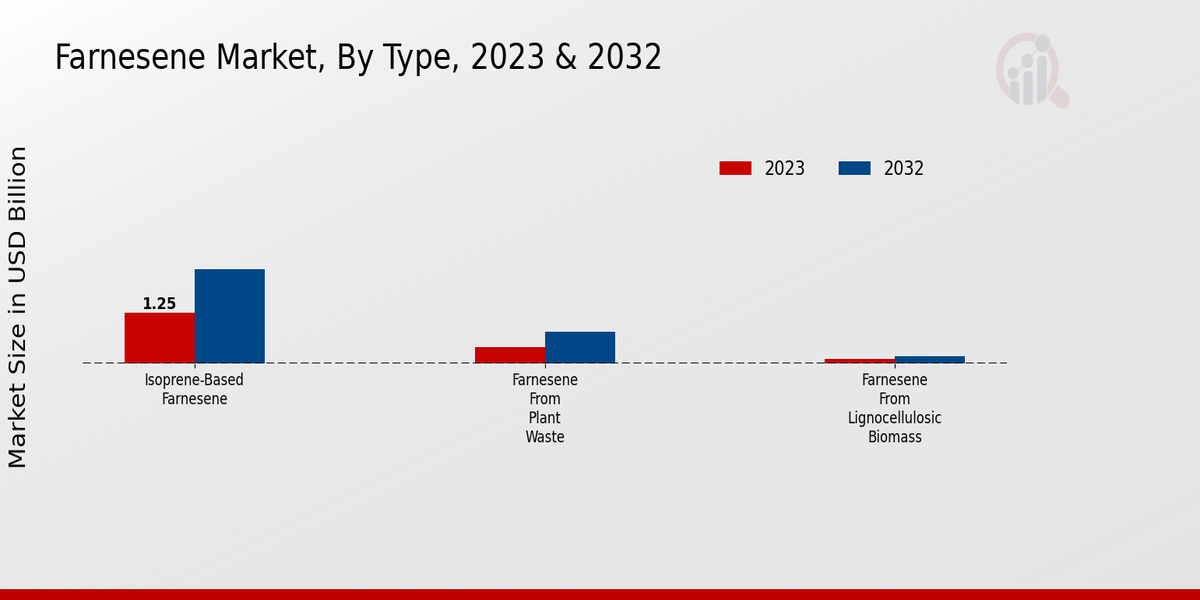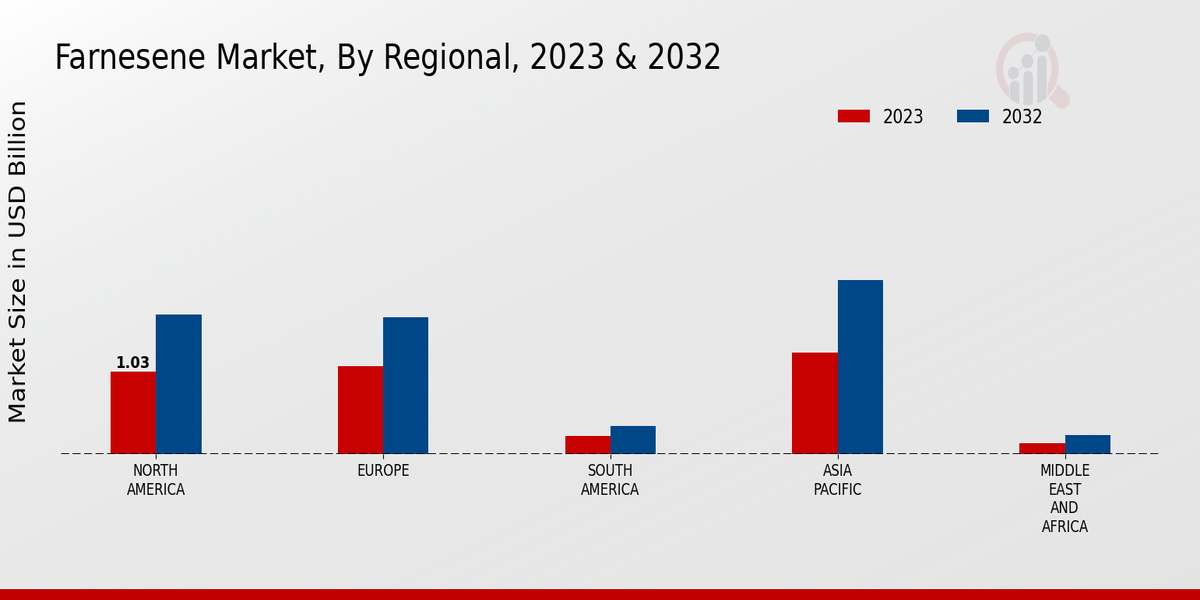Global Farnesene Market Overview
The Farnesene Market Size was estimated at 2.04 (USD Billion) in 2024. The Farnesene Industry is expected to grow from 2.18 (USD Billion) in 2025 to 3.89 (USD Billion) by 2034. The Farnesene Market CAGR (growth rate) is expected to be around 6.7% during the forecast period (2025 - 2034).
Key Farnesene Market Trends Highlighted
Market Trends in Farnesene Market:In the burgeoning Farnesene market expanding at a steady CAGR, several key trends are shaping industry dynamics. The market is driven by the increasing demand for farnesene in the production of flavors, fragrances, and pharmaceuticals. The growing popularity of natural and sustainable products is driving the adoption of farnesene as a renewable and biodegradable alternative to synthetic chemicals.Opportunities for exploration and capture in the market lie in the emergence of new applications in various industries. Farnesene is gaining traction in the production of biofuels, lubricants, and polymers. The rising demand for plant-based products in the cosmetics and personal care industries offers significant growth potential.Recent trends include the development of bio-based farnesene from renewable sources. This has enhanced the sustainability profile of farnesene and increased its appeal to environmentally conscious consumers. Technological advancements in extraction and purification processes have led to improved product quality and reduced production costs, further bolstering market growth.
 Source: Primary Research, Secondary Research, MRFR Database and Analyst Review
Farnesene Market Drivers
Rising Demand for Bio-Based Products
Source: Primary Research, Secondary Research, MRFR Database and Analyst Review
Farnesene Market Drivers
Rising Demand for Bio-Based Products
The growing awareness of the environmental impact of traditional petroleum-based products has led to an increasing demand for bio-based alternatives. Farnesene, a renewable resource derived from plant sources, is gaining popularity as a sustainable substitute for synthetic ingredients in various industries. Its biodegradability and non-toxicity make it an attractive option for manufacturers seeking eco-friendly solutions. The rising demand for bio-based products is expected to drive the growth of the Farnesene Market Industry over the forecast period.
Expanding Applications in Personal Care and Cosmetics
Farnesene's unique properties, such as its pleasant scent and emollient qualities, make it a valuable ingredient in the personal care and cosmetics industry. It is widely used in fragrances, skincare products, and hair care formulations. Farnesene's ability to enhance skin hydration and reduce the appearance of wrinkles has contributed to its growing popularity in anti-aging and moisturizing products. The expanding applications of farnesene in personal care and cosmetics are expected to fuel market growth in the coming years.
Growth of the Pharmaceutical Industry
Farnesene has gained significant attention in the pharmaceutical industry due to its potential therapeutic applications. Studies have shown that farnesene exhibits anti-inflammatory, antimicrobial, and anticancer properties. As a result, it is being investigated for the development of new drugs and treatments for various diseases. The growth of the pharmaceutical industry and the ongoing research into the therapeutic potential of farnesene are expected to drive market demand in the future.
Farnesene Market Segment Insights
Farnesene Market Type Insights
Isoprene-based farnesene, farnesene from plant waste, and farnesene from lignocellulosic biomass are the three main types of farnesene. Isoprene-based farnesene had the largest market share of nearly 70% in 2023 and is projected to reach USD 2.3 billion by 2032, exhibiting a CAGR of 6.5% during the forecast period. Farnesene from plant waste is also projected to showcase significant growth during the forecast period, with a CAGR of 7.2%. Farnesene from lignocellulosic biomass is expected to experience moderate growth, with a CAGR of 5.8% during the forecast period. The farnesene market is segmented based on type into isoprene-based farnesene, farnesene from plant waste, and farnesene from lignocellulosic biomass. Isoprene-based farnesene is the most common type of farnesene and is produced from isoprene, a hydrocarbon that is found in natural gas and petroleum. Farnesene from plant waste is produced from the waste products of plants, such as corncobs and sugarcane bagasse. Farnesene from lignocellulosic biomass is produced from the cellulose and hemicellulose found in plant cell walls.
 Source: Primary Research, Secondary Research, MRFR Database and Analyst Review
Farnesene Market Grade Insights
Source: Primary Research, Secondary Research, MRFR Database and Analyst Review
Farnesene Market Grade Insights
The Farnesene Market is segmented by Grade into Technical Grade, Pharmaceutical Grade, Food Grade, and Cosmetic Grade. Among these segments, the Technical Grade segment held the largest market share in 2023, accounting for over 50% of the Farnesene Market revenue. The Pharmaceutical Grade segment is expected to witness significant growth during the forecast period, owing to the increasing demand for farnesene in the production of pharmaceuticals and personal care products. The Food Grade segment is also expected to grow at a steady pace, driven by the rising demand for natural and healthy food additives.The Cosmetic Grade segment is expected to witness moderate growth, owing to the increasing use of farnesene in the production of cosmetics and fragrances.
Farnesene Market Application Insights
The Farnesene Market segmentation by Application is categorized into Biofuel Production, Rubber Production, Pharmaceuticals, Personal Care Products, and Industrial Chemicals. Among these segments, Biofuel Production is anticipated to dominate the market with a notable Farnesene Market revenue share in 2023, owing to the increasing demand for renewable energy sources. Additionally, Rubber Production is projected to exhibit significant growth potential due to the rising consumption of natural rubber in various industries. The Pharmaceuticals segment is expected to contribute a substantial share, driven by the growing demand for farnesene-based drugs and treatments.Personal Care Products and Industrial Chemicals segments are also anticipated to witness steady growth, supported by the increasing use of farnesene in cosmetics and industrial applications, respectively.
Farnesene Market Distribution Channel Insights
The Farnesene Market segmentation by Distribution Channel is a critical aspect of market research. In 2023, the Direct Sales segment accounted for the largest share of the Farnesene Market revenue, with a value of around USD 750 million. This segment is expected to maintain its dominance throughout the forecast period, reaching a projected value of USD 1.2 billion by 2032. The growth of the Direct Sales segment can be attributed to the increasing preference for direct interactions between manufacturers and customers, allowing for better control over product quality and pricing.The Distributors segment is another significant channel, holding a substantial market share in 2023. Distributors play a crucial role in connecting manufacturers with a wider customer base and ensuring efficient product distribution. The Online Marketplaces segment is gaining traction due to the rising popularity of e-commerce platforms, offering convenience and a wider product selection for customers. This segment is anticipated to witness significant growth in the coming years, driven by the increasing adoption of online shopping.
Farnesene Market End-use Industry Insights
The Farnesene Market segmentation by end-use industry offers valuable insights into the diverse applications of Farnesene across various sectors. In 2023, the Automotive industry held a significant market share, driven by the increasing demand for bio-based and sustainable materials in the automotive sector. The Pharmaceutical industry is projected to witness steady growth due to the rising adoption of Farnesene as an excipient and active ingredient in drug formulations. The Healthcare industry utilizes Farnesene in medical devices and surgical applications, contributing to market growth.The Personal Care industry leverages Farnesene's properties as a fragrance ingredient and emollient in cosmetic and skincare products. The Chemical industry utilizes Farnesene as a raw material for the production of polymers, resins, and other chemicals. As per market research, the Farnesene Market is expected to continue its growth trajectory over the forecast period, with each end-use industry contributing to the overall market expansion.
Farnesene Market Regional Insights
The Farnesene Market is segmented into North America, Europe, APAC, South America, and MEA. North America held the largest market share in 2023 and is expected to continue its dominance throughout the forecast period. The growth of the North American market is attributed to the increasing demand for farnesene in the food and beverage industry. Europe is the second-largest market for farnesene, followed by APAC. The APAC market is expected to grow at the highest CAGR during the forecast period due to the increasing demand for farnesene in the pharmaceutical and personal care industries.South America and MEA are expected to witness moderate growth in the Farnesene market. The Farnesene Market is expected to reach a market valuation of 3.2 billion USD by 2032, growing at a CAGR of 6.68 % from 2023 to 2032.
 Source: Primary Research, Secondary Research, MRFR Database and Analyst Review
Farnesene Market Key Players And Competitive Insights
Source: Primary Research, Secondary Research, MRFR Database and Analyst Review
Farnesene Market Key Players And Competitive Insights
Major players in the Farnesene Market are constantly engaging in strategic initiatives to maintain their competitive edge. These initiatives include collaborations, acquisitions, and investments in research and development. Leading Farnesene Market players are focusing on developing innovative products and solutions to cater to the evolving needs of customers. The Farnesene Market industry is characterized by intense competition, with key players vying for market share through various strategies. Farnesene Market development initiatives include expanding into new geographic markets, enhancing production capabilities, and diversifying product portfolios. The Farnesene Market Competitive Landscape is expected to remain dynamic in the coming years, with ongoing technological advancements and changing market dynamics. Key players are investing in research and development to introduce new and improved products to meet customer demands.A leading player in the Farnesene Market is Amyris, Inc. The company is known for its innovative and sustainable production of farnesene from renewable feedstocks. Amyris, Inc. has a presence, and its products are used in various applications, including fragrances, flavors, and biofuels. The company's commitment to sustainability has earned it recognition as a leader in the industry.Another notable competitor in the Farnesene Market is Archer Daniels Midland Company (ADM). ADM is a leader in the agricultural and food processing industries. The company's Farnesene business is focused on producing high-quality Farnesene from renewable sources. ADM's reach and extensive distribution network enable it to supply customers worldwide. The company's emphasis on innovation and sustainability has positioned it as a major player in the Farnesene Market.
Key Companies in the Farnesene Market Include
- Braskem S.A.
- Chevron Phillips Chemical Company
- LyondellBasell Industries Holdings B.V.
- Eni S.p.A.
- Repsol S.A.
- SIBUR Holding PJSC
- QatarEnergy
- BASF SE
- Exxon Mobil Corporation
- SABIC
Farnesene Market Industry Developments
Rising demand for biofuels, increasing use in the food and beverage industry, and growing adoption in the personal care and cosmetics sector are the key factors driving the growth of the market.Recent news developments in the Farnesene market include the launch of new products, expansions, and partnerships. For instance, in January 2023, Amyris, Inc. announced the launch of its renewable farnesene-based diesel fuel, which is expected to reduce greenhouse gas emissions by up to 80% compared to traditional diesel. Additionally, in March 2023, Archer Daniels Midland Company (ADM) announced a partnership with Gevo, Inc. to develop and commercialize sustainable aviation fuel (SAF) made from farnesene. These developments indicate the growing interest and investment in the Farnesene market.
Farnesene Market Segmentation Insights
Farnesene Market Type Outlook
- Isoprene-based Farnesene
- Farnesene from Plant Waste
- Farnesene from Lignocellulosic Biomass
Farnesene Market Grade Outlook
- Technical Grade
- Pharmaceutical Grade
- Food Grade
- Cosmetic Grade
Farnesene Market Application Outlook
- Biofuel Production
- Rubber Production
- Pharmaceuticals
- Personal Care Products
- Industrial Chemicals
Farnesene Market Distribution Channel Outlook
- Direct Sales
- Distributors
- Online Marketplaces
Farnesene Market End-use Industry Outlook
- Automotive
- Pharmaceutical
- Healthcare
- Personal Care
- Chemical
Farnesene Market Regional Outlook
- North America
- Europe
- South America
- Asia Pacific
- Middle East and Africa
| Report Attribute/Metric |
Details |
| Market Size 2024 |
2.04 (USD Billion) |
| Market Size 2025 |
2.18 (USD Billion) |
| Market Size 2034 |
3.89 (USD Billion) |
| Compound Annual Growth Rate (CAGR) |
6.7% (2025 - 2034) |
| Report Coverage |
Revenue Forecast, Competitive Landscape, Growth Factors, and Trends |
| Base Year |
2024 |
| Market Forecast Period |
2025 - 2034 |
| Historical Data |
2020 - 2024 |
| Market Forecast Units |
USD Billion |
| Key Companies Profiled |
Braskem S.A., Chevron Phillips Chemical Company, LyondellBasell Industries Holdings B.V., Eni S.p.A., Repsol S.A., SIBUR Holding PJSC, QatarEnergy, BASF SE, Exxon Mobil Corporation, SABIC |
| Segments Covered |
Type, Grade, Application, Distribution Channel, End-use Industry, Regional |
| Key Market Opportunities |
Growing demand in food and beverages, pharmaceuticals, and personal care products Rising use in biofuels Potential for sustainable production Technological advancements Expanding applications in cosmetics and fragrances |
| Key Market Dynamics |
Rising demand for biobased chemicals Growing popularity of natural fragrances Expansion of biofuel industry Technological advancements in biobased production Favourable government policies |
| Countries Covered |
North America, Europe, APAC, South America, MEA |
Frequently Asked Questions (FAQ) :
The Farnesene Market is anticipated to grow at a CAGR of 6.7% from 2025 to 2034.
The Farnesene Market was valued at approximately USD 2.04 billion in 2024.
By 2034, the Farnesene Market is projected to reach an overall valuation of around USD 3.89 billion.
The Asia-Pacific region is anticipated to hold the largest market share in the Farnesene Market.
Farnesene finds applications in various industries, including flavors and fragrances, cosmetics, and pharmaceuticals.
Some of the prominent competitors in the Farnesene Market include Firmenich, Givaudan, and Symrise.
The Farnesene Market is expected to witness significant growth due to increasing demand from end-use industries and the expansion of applications.
The Farnesene Market may face challenges related to raw material availability and price fluctuations.
The Farnesene Market presents opportunities for innovation in product development and the expansion of applications in emerging markets.
Key trends in the Farnesene Market include the increasing demand for bio-based products and the adoption of sustainable practices.
















